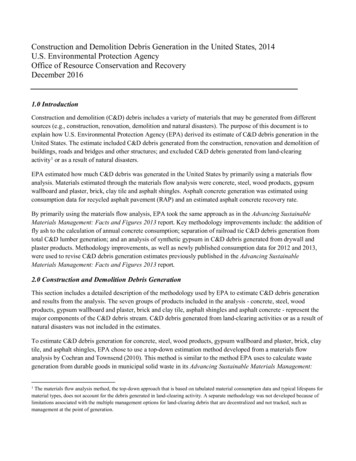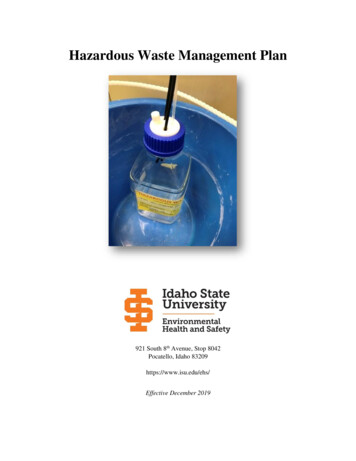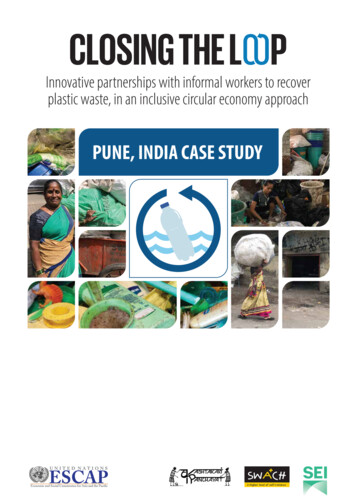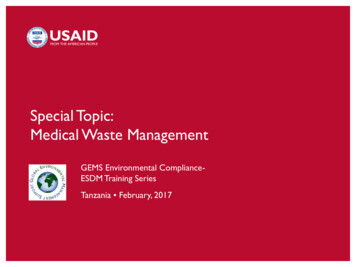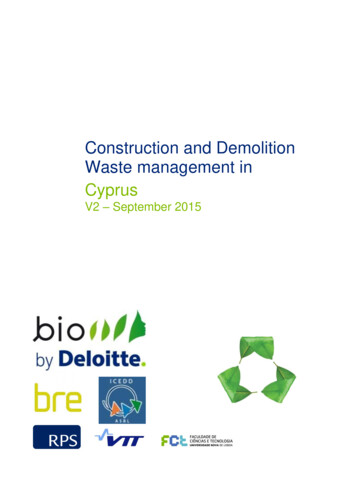
Transcription
Construction and DemolitionWaste management inCyprusV2 – September 2015
Table of contentsSCREENING FACTSHEET 31.2.Summary 3Definitions concerning construction and demolition waste (CDW) and management 52.1. Definition of waste2.2. Definition of construction and demolition waste (CDW)2.3. End of Waste (EoW) status2.4. Definitions of waste treatment operations3.Legal Framework – Waste Management Plans and Strategies 63.1.3.2.3.3.3.4.4.5.6678CDW generation dataCDW treatment dataCDW exports/imports dataCDW treatment facilities dataFuture projections of CDW generation and treatmentMethodology for CDW statistics101011111212C&D waste management in practice 126.1.6.2.6.3.6.4.7.Legislation concerning CDW in CyprusWaste management plans (WMP) and StrategiesLegal framework for sustainable management of CDWTargetsNon legislative instruments 8CDW management performance – CDW data 105.1.5.2.5.3.5.4.5.5.5.6.6.5555CDW management initiativesStakeholders’ engagementWaste legislation enforcementDrivers / barriers to increase CDW recycling12121213CDW sector characterisation 157.1.7.2.7.3.7.4.7.5.7.6.Sector characteristicsExports / imports of CDWCDW as landfill coverMarket conditions / costs and benefitsRecycled materials from CDWConstruction sector make up151515151616REFERENCES 182Resource Efficient Use of Mixed Wastes
Screening factsheet1. SummaryThe management of Construction and Demolition Waste (CDW) in Cyprus faces several challenges andappears to be underperforming, despite the fact that a comprehensive legislative framework concerning themanagement of CDW is in place since 2011 (with several new legislation, regulations and amendmentsfollowing up since then).Construction and Demolition Waste (CDW) management national performanceLatest available data for CDW generation and treatment in Cyprus is the Eurostat data for 2012. Dataconcerning CDW in Cyprus rely mainly on estimations since national reporting is not sufficient to describethe actual situation in Cyprus. Data collection is gradually improving but at a low pace. Preliminary data for2014, through the reporting of the officially certified CDW Management System organisations, coverapproximately half of the CDW amounts generated and treated in Cyprus. The data reported to Eurostat for2012, do not include soils and naturally occurring materials from excavations.Waste categoryNon-hazardous CDWHazardous wasteTotal CDWGenerated in 2012 (ktons)Recovered in 2012 (ktons)142.20142.283.4083.4In 2012, about 142 thousand tonnes of CDW was generated in Cyprus, of which 62 thousand tonnes weremechanically recovered and about 21 thousand tonnes were used for backfilling. The remaining amount wassent to landfills. CDW generation is decreasing steadily since 2010, due to the significant slowdown in theconstruction sector and is not expected to recover in the foreseeable future.CDW generation including soils is estimated to be at least 3 times higher than the figures reported toEurostat. There is also a significant amount of CDW which slips through the official CDW ManagementSystems and is not reported or accounted for in any statistics, official or unofficial. Only rough estimationscan be drawn for CDW that is illegally managed.Taking into account Eurostat data and according to the calculation method described in CommissionDecision 2011/753/EU for verifying compliance with WFD targets, Cyprus reached approximately 59%recovery rate of CDW in 2012.However, this doesn’t seem to be the case comparing recent data reported by the largest System forManagement of CDW in Cyprus (OAK). The definition of CDW in Cyprus includes soils and naturallyoccurring materials which are also counted in the calculation of recovery rates, as presented in the AnnualReport of OAK for 2014. Taking into account the estimated total generation and the actual treatment of CDW(incl. soils) by OAK in Cyprus, the recovery rate for 2014 is calculated at 45%. Excluding soils from theabove calculation results in a recovery rate of 14%.There is a need for transparent reporting and care in the calculation methodology by the Cypriot authoritieswhen submitting their calculation of the WFD targets, in order to avoid any discrepancies and misreportingthat might lead to non-compliance with the WFD targets. So far, Cyprus has not officially reported any dataon CDW generation and recovery pursuant to Commission Decision 2011/753/EU.CDW management practicesAccording to legislation, actors in the construction sector (construction works contractors, demolishers, etc.)are obliged to organise CDW Management Systems (either single legal entity organisations or collectiveorganisations with many participants) for the proper management of CDW from their operations. The CDWManagement Systems are entitled to organise the whole waste management chain (from collection to finalrecovery, disposal and return to the market of the recycled product).CDW produced in the construction/demolition site is transported to CDW treatment facilities where it issorted and processed into final recycled products. The fraction of the received CDW that is not materially3Resource Efficient Use of Mixed Wastes
recovered is deposited into landfills or used for purposes such as backfilling. The main product of CDWtreatment facilities is aggregates for use in road works and other mild landscaping and engineeringpurposes.In practice however, large quantities of CDW is illegally managed and as a result none of the abovedescribed procedures takes place. In the case of illegal CDW management, the whole load of CDWgenerated in the construction/demolition site is transported and disposed without prior planning orenvironmental permitting in natural sites (e.g. mountain sides, water courses, etc.) preferably in remotelocations which are difficult to be detected by environmental inspectors.Finally, large quantities of CDW is re-used on site for landscaping and other engineering purposes. Theamount of CDW re-used on site is not reported as CDW generated or treated and thus is not taken intoaccount for the calculation of national/EU targets. There is no official estimation available about the volumeof CDW re-used this way on site.Main obstacles to sustainable CDW management Lack of political will There is low political will to tackle the issue of illegal CDW disposal. Major delays in theapplication of the laws and complementary regulations for CDW. Low organisational capacity for implementation and/or enforcement of the law. Delays in administration of fines or non-conviction of CDW management rules violators Mentality in the construction sector General mentality in the construction sector (and of the general public in Cyprus) is that CDWis not considered to be a waste stream that requires immediate attention and treatment. It canbe disposed somewhere and left there, since its inert nature makes it harmless for humanhealth and the environment. Contractors prefer to avoid the cost of CDW management. General lack of skills and knowledge to organise effective systems of CDW management. No market/no demand for recycled CDW, natural materials are always preferred over recycledmaterials in the construction works. Lack of treatment facilities and low territorial network The current network of CDW treatment facilities is not sufficient to cover the total amount ofgenerated CDW in the whole territory of Cyprus Lack of incentives for recycling There is no landfill tax or other adequately deterrent financial instruments for diverting CDWfrom landfilling to recovery. Cost of recovery activities is higher than the prices of the recycled end-product. No pull effectfrom market conditions. No standards for recycled materialsMain drivers to sustainable CDW management 4Existence of a well-articulated legal framework for CDW management including provisions for thesustainable management of CDW.Organisation of CDW Management Systems by the actors in the construction sector (obliged bylegislation) for the sustainable management of CDWResource Efficient Use of Mixed Wastes
2. Definitions concerning construction and demolition waste (CDW) andmanagementIn this section the definitions of waste used in Cyprus are presented.2.1. Definition of wasteThe Waste Framework Directive (WFD) 2008/98/EC was transposed in Cypriot legislation in the Waste Law1of 2011 (Ν. 185(Ι)/2011) . The definition of waste used in Cyprus is in line with that in the WFD.‘waste’ means any substance or object which the holder discards or intends or is required to discard;2.2. Definition of construction and demolition waste (CDW)The applied definition of CDW in Cyprus includes all types of waste in Chapter 17 of the European List ofWaste (2000/532/EC). This means that soils and naturally occurring materials from excavation activities arealso included in calculating the generation of CDW. Specifically, the definition of CDW in Cyprus is found inthe Solid and Hazardous Waste (Management of Excavation, Construction and Demolition Waste)2Regulations of 2011 (P.I. 159/2011) , and is as follows:‘waste from excavation, construction and demolition means any material or object deriving from excavations,construction and demolition waste that is considered as waste and is included in category 17 of the Order ofSolid and Hazardous Waste (Waste Catalogue) of 2003 (P.I. 157/2003).’There is a distinction between waste deriving from excavation, construction and demolition activities, but nodistinct definitions are provided in the relevant legislation.Although soil and naturally occurring excavated materials during the course of construction are included inthe definition of CDW, these are not considered in the definition of CDW for calculating the WFD target aspresented in Commission Decision 2011/753/EU. The LoW categories excluded in the latter definition are 1705 04 and 17 05 06.2.3. End of Waste (EoW) statusThere are no End of Waste criteria established in Cyprus, nor being developed.2.4. Definitions of waste treatment operationsThe definitions for re-use, recycling and recovery used in Cyprus are found in the Waste Law of 2011 (Ν.185(Ι)/2011) and they are the same as those found in the WFD following the categorisation in Annex II of theWFD. Specifically, they are define as: ‘re-use’ means any operation by which products or components that are not waste are used againfor the same purpose for which they were conceived;‘recovery’ means any operation the principal result of which is waste serving a useful purpose byreplacing other materials which would otherwise have been used to fulfil a particular function, orwaste being prepared to fulfil that function, in the plant or in the wider economy. Annex II sets out anon-exhaustive list of recovery operations;‘preparing for re-use’ means checking, cleaning or repairing recovery operations, by which productsor components of products that have become waste are prepared so that they can be re-usedwithout any other pre-processing;‘recycling’ means any recovery operation by which waste materials are reprocessed into products,materials or substances whether for the original or other purposes. It includes the reprocessing of1http://www.cylaw.org/nomoi/arith/2011 1 97009AE4E64C2257B0500435197/ ent25Resource Efficient Use of Mixed Wastes
organic material but does not include energy recovery and the reprocessing into materials that are tobe used as fuels or for backfilling operations;3The Statistical Service of Cyprus (CYSTAT) follows the guidelines of Eurostat in reporting . The StatisticalService is using a hybrid approach of surveys and estimations for producing data on CDW generation andtreatment. This waste stream is not monitored satisfactorily and there is a lack of data resulting from limitedresponse to survey questionnaires. As a result, the amounts of CDW generated and treated and theavailable treatment options are mostly estimated by the actors involved in the sector, coupled with statisticalanalysis, rather than actually measured.However, the situation is rapidly changing as the obligation of treatment of CDW through certified systems ofCDW management (single entity or cooperative systems) means that more and more CDW going throughthe official channels of CDW management will be documented and accurately reported. The total amount ofCDW treated by the CDW management systems currently (as of May 2015) do not represent the totalamount of CDW generated in Cyprus, so estimations are still necessary in order to draw comprehensive datafor the situation in Cyprus.3. Legal Framework – Waste Management Plans and StrategiesIn this section the legal framework governing CDW management in Cyprus is presented.3.1. Legislation concerning CDW in CyprusThe legislative framework for waste management in Cyprus is defined by the Waste Law of 2011 (Ν.4185(Ι)/2011) , which transposes the EU Waste Framework Directive (2008/98/EC) into Cypriot law. Allprovisions in the WFD related to CDW are valid for Cyprus and form the legal basis for the management ofCDW in the country.The Solid and Hazardous Waste (Management of Excavation, Construction and Demolition Waste)5Regulations of 2011 (P.I. 159/2011) , stipulates measures and conditions for the efficient management ofexcavation, construction and demolition waste (ECDW). Here, the obligations of all actors involved in themanagement of CDW is presented with emphasis on increasing the re-use and recovery of CDW followingthe waste hierarchy.Other regulations and orders governing environmental permits, as well as urban planning regulations arealso relevant to the CDW stream.3.2. Waste management plans (WMP) and Strategies6The Waste Management Plan of Cyprus was published in 2004 and contains a dedicated chapter for themanagement of CDW. However, the reference period of data and information as well as the managementoptions included in this chapter are considered outdated and do not represent the current situation in Cyprus,which is completely different. Data on CDW generation date back to the period 1995-1999.The Waste Prevention Programme of Cyprus, pursuant to Article 29 of the WFD is currently underpreparation and no specific information concerning CDW have been obtained during the course of this study.No other strategic document concerning the management of CDW was OpenDocumenthttp://www.cylaw.org/nomoi/arith/2011 1 D97009AE4E64C2257B0500435197/ ocument46Resource Efficient Use of Mixed Wastes
3.3. Legal framework for sustainable management of CDWDescriptionLevel of occurrence(Yes/No)Key Scope/ExemptionsNational/regional obligationfor selective demolitionNONational/regional sortingobligation (on-site or insorting facility)NONational/regional separatecollection obligation fordifferent materials (iron andsteel, plastic, glass, etc.)NOObligation for separatecollection and managementof hazardous waste fromC&D operations - PleasespecifyYES – NationalRelated Green publicprocurement requirementsNOObligation for participationto, or establishment of CDWmanagement systems, bythe construction/demolitionproject contractors (CDWproducers)YES – NationalObligation to submitdetailed CDW ManagementPlan for the amount of CDWgenerated from theconstruction/demolitionactivities, by the projectcontractorsYES – NationalObligation of contractors tofollow the principles of thewaste hierarchy during thecourse of the constructionprojectYES – NationalObligation of contractors tomaintain detailed register ofCDW quantities generated,by waste type and itstreatment optionsYES – NationalObligation to increase theuse of recycled materials inconstruction, by the projectcontractors, and to receiverecycled materials from theofficial CDW managementsystems for use in theconstruction projectsYES – National7Year established andpolicy referenceFurther detail,information source,related web-site2011P.I. 159/20112011P.I. 159/20112011P.I. 159/20112011P.I. 159/20112011P.I. 159/20112011P.I. 159/2011Resource Efficient Use of Mixed Wastes
Level of occurrence(Yes/No)Key Scope/ExemptionsYear established andpolicy referenceObligation of collection ofCDW only by the certifiedsystems of alternative CDWmanagementYES – National2011Obligation for the re-use, orreturn back to the providerof recycled constructionmaterials not used in theconstruction projectYES – NationalDescriptionFurther detail,information source,related web-siteP.I. 159/20112011P.I. 159/20113.4. TargetsThe only applicable target in Cyprus concerning CDW is the target of 70% recovery by 2020 of the WFD. Forthe calculation of the level of the WFD target, Cyprus is required to follow the Commission Decision2011/753/EU calculation method and exclude the amounts of soils and naturally occurring materials (wastecodes 17 05 04 and 17 05 06) from the calculation of the target. This will be possible in the future, due todetailed data provided by the licenced CDW management systems in Cyprus. So far, Cyprus has notreported official data on the generation and treatment of CDW pursuant to Decision 2011/753/EU.There are no specific targets concerning the re-use, recycling or recovery of specific material waste streamsthat are used in construction.In 2015, OAK CDW Management System is preparing to start its ambitious five-year campaign to reduce7CDW generation by 50% per square metre by 2020 .There is no specific mention of backfilling practices in Cyprus. However, the large amounts of recovery7reported by the CDW management system OAK consist mainly of re-use of soils and backfilling in largescale technical projects (e.g. sewage system).Pursuant to the current legislation, all generated CDW should be diverted to certified CDW managementsystems and the amounts of CDW used for backfilling will be appropriately reported.4. Non legislative instrumentsIn this section, other instruments that may specify how the country is addressing the question of CDWmanagement is presented as these instruments might be creating conditions for a sustainable managementof CDW.DescriptionLevel of occurrence(Yes/No)Key Scope/ExemptionsSustainability standards thatcover CDW (e.g. BREEAM)NOExtended producerresponsibility schemeNO7Year established andpolicy referenceFurther detail,information source,related web-siteOAK (Cyprus Recycling Organisation), Annual Report 20148Resource Efficient Use of Mixed Wastes
e &exemptionsRequirementfor predemolitionauditsNOStandards forrecycled CDWYES – Notmandatory,but requiredin order forCDW to bemarketedSelectivedemolition/ planfor largedemolitionsites/demolitionstandardNOGuarantee forthe fulfilment ofCDWmanagementobligations bythe nal(specify ifregional)2003NationalDetails ofPublic sectorand nisationwith ConstructionProductsRegulation (EU)No. 305/2011Levels ofperformancee.g. -siteThesestandardsrefer toproducts andnot waste.BUT in orderfor CDW toreturn to themarket, needto fulfil thesestandardsAre theseobligationsenforced inpractice?2011NationalRequired by theBuilding andurban planningauthorities inorder to makesure that themanagement ofCDW will complywith existinglegislationn.a.Ministry ofInteriorThere is very limited use of other non-legislative instruments in Cyprus to address the issue of resourceefficient use of CDW.There is also a lack of information concerning the management of hazardous waste from construction anddemolition activities. Project contractors are obliged by legislation to remove separately the hazardousmaterials of CDW and to deliver them to licenced entities for the transportation and treatment of hazardous8waste, according to the Solid and Hazardous Waste Management Law (N. 215(1)/2002) .The fact that no data on hazardous CDW are reported at all in Cyprus raises concern about the managementpractices of this type of waste. Further investigation would be required in order to track and account any typeof hazardous waste that derives from construction and demolition activities in penDocument9Resource Efficient Use of Mixed Wastes
5. CDW management performance – CDW dataData on the generation and treatment of CDW in Cyprus are collected by the Statistical Service of Cyprus(CYSTAT) through surveys and complemented with estimations in order to fill data gaps and/or low qualitydata. The last survey period for waste data gathering was in 2011, collecting data for 2010 reference period.Data for 2012 appear in the Eurostat database and constitute a product of statistical estimation by Eurostat,rather than actual data reported by CYSTAT.So far, data collected by CYSTAT was based on surveys and estimations. However, a large amount of CDWwas not recorded since it slipped through official treatment options and was not managed properly. As aresult, the reported amounts of CDW generated and treated might not reflect the real situation in Cyprus.Since the establishment of the first CDW management systems in 2014, it is expected that the quality ofreported data will improve significantly in the following years. So far, there are five licenced CDWmanagement systems active in Cyprus. Three of them are ‘single entity’ systems, which means that areestablished by a single contractor/producer of CDW. The other two are collective CDW managementsystems, where many contractors participate. The first CDW management system licenced in 2014 has 121members, representing around 7% of contractors in Cyprus. However, in 2014 managed nearly half of all theCDW generated in Cyprus.Data reported by the Statistical Service of Cyprus follow the Waste Statistics Regulation (2150/2002/EC).The focus of CDW statistics is on the construction sector (code F in NACE Rev.2). It is not possible todistinguish between wastes coming from construction, demolition or renovation activities.The only official source of CDW data, which maintains a consistent time series, is the Statistical Service ofCyprus (CYSTAT). CYSTAT is reporting to Eurostat and therefore the data in Eurostat database are thesame (pursuant to Waste Statistics Regulation 2150/2002/EC) as the data found in CYSTAT’s database,although the latter is not updated. Last data available on CYSTAT database is for 2010.5.1. CDW generation dataData on CDW generation are presented in Table 1, excluding soils and naturally occurring materials. Data onCDW generation in the official statistics exist only for even years.Table 1: CDW generation in CyprusCDW generation (tonnes)920102012Total166 549142 249Non-hazardous155 139142 249Hazardous11 4100However, the CDW stream in Cyprus is considered to include soils and the total quantities of CDWgenerated (incl. soils) is taken into account by the CDW management system organisations.Due to economic constraints and the slowing down of construction activities in Cyprus, the generation of10CDW is decreasing drastically over the last years .5.2. CDW treatment dataThe latest available data on CDW treatment presented in Table 2 refer to the year 2012. Since CDWtreatment data was not produced by the Statistical Service of Cyprus (CYSTAT) for 2012, Eurostat data isused to present the treatment situation in Cyprus. Data on CDW treatment in the official statistics exist onlyfor even years.9Eurostat Waste database: Generation of waste (env wasgen)Annual Report 2014, OAK (Cyprus Recycling Organisation)1010Resource Efficient Use of Mixed Wastes
11Table 2: CDW treatment in 2012CDW treatment (tonnes)Landfill/Disposal Energy recovery(D1-D7, D12)(R1)BackfillingRecovery otherthan energyrecovery Except backfillingTotal54 801021 29162 129Non-hazardous54 801021 29162 1290000HazardousComparing Table 2 to Table 1, the quantity of CDW reported under the different treatment options in total islower than the quantity of CDW generated. There is a certain amount of CDW missing, which means that theremaining CDW was not treated or the final treatment destination was unknown. However, the missingamount could also be attributed to misreporting.The first CDW management system organisation (OAK) obtained its licence on 14 February 2014. It has justover a year in operation and recently submitted its annual activity report to the responsible authoritiesconcerning CDW (Ministry of Interior). Three more CDW management systems (single entity organisationsestablished by a single construction contractor) have been licenced in 2014 for treating individually wasteproduced by their own operation. Finally, in 11 March 2015 another collective CDW management system12was licenced , which will contribute to the effort of collecting and treating CDW from construction/demolitionoperations across Cyprus.With more CDW management systems starting their operations, comprehensive data on the recovery ofCDW are going to be reported systematically in the following years. CDW management systems are obligedto yearly reporting of the CDW treated amounts and to keep full traceability of CDW within their operations.The CDW management systems are obliged to maintain detailed data on the receiving quantities of CDWincluding the source of the waste, distinguishing between new construction, renovation and demolition.The first results from the only CDW management system (OAK) active since early in 2014, show anencouraging development in the management and recovery of CDW in Cyprus. OAK managed 48.7% of thetotal generated CDW estimated for 2014 in Cyprus Out of this amount, OAK managed to recover 92%, which13corresponds to around 44.8% of the total amount of estimated CDW in 2014 .However, that main waste fraction recovered was soils and naturally occurring materials (waste codes 17 0504, 17 05 06), which is excluded from the calculation of the WFD target. This means, that although the CDWmanagement systems in Cyprus recover a great amount of CDW (incl. soils), the performance of the countryaccording to the WFD remains low. Subtracting the quantities of soils recovered (by analysing the detailed13data found in the Annual Report of OAK ), the recovery rate for Cyprus, following the calculation method ofCommission Decision 2011/753/EU, is only 14%.5.3. CDW exports/imports dataThere is no data available concerning the exports and imports of CDW.5.4. CDW treatment facilities dataThere are two licenced treatment facilities of CDW in Cyprus and an additional one which is temporarily outof order, since basic infrastructure is missing for the proper access and use of the site. The latter will resumeoperation when all appropriate works are finalised, however there is no certain timeline at the moment as towhen the facility can be operational. The CDW treatment facilities are situated in locations of old quarriesand both include designated areas of inert CDW landfills. The licences obtain by these facilities allow for thefollowing treatment operations: D1, D15, R4, R5, R13 (according to classification in Annexes I and II of the12WFD) . The CDW treatment facilities receive CDW from the affiliated CDW management systems for11Eurostat Waste database: Treatment of waste (env 43FC5FC5B36C2257AA2002D1C4813OAK (Cyprus Recycling Organisation), Annual Report 20141211Resource Efficient Use of Mixed Wastes
recovery, while the quantities that cannot be recovered are landfilled at the same location, avoiding14additional transport. There are also two other separate locations designated in Cyprus for inert landfills .One in Paphos and one in Limassol.There is no data about the capacity of the treatment facilities nor about the landfill sites for inert waste.However, the two facilities are not serving satisfactorily the network of CDW producers, since many areasare not covered locally and therefore need to transport the generated CDW over long distances with highercosts. As a result, it is often observed that CDW never reach the treatment facilities and are dumpedsomewhere close to the construction site instead. More CDW treatment facilities are required in Cyprus forimproving the recovery performance and resource efficient management of CDW on the island.5.5. Future projections of CDW generation and treatmentThere are no official future projections of CDW generation and treatment in Cyprus. However, CDW isclosely linked to construction activities and the CDW Management Systems use the indices of construction(maintained by CYSTAT) to produce estimations of expected CDW generation in order to plan their activitiesfor the future.5.6. Methodology for CDW statisticsThe methodology used by CYSTAT for gathering data on CDW follows Eurostat guidelines as explained inthe manual on waste statistics. No changes in methodology have been made since the previously reporteddata to Eurostat for 2010.6. C&D waste management in practiceIn this section the CDW management “on ground” in Cyprus is presented. Specific CDW initiatives, voluntaryagreements and any other management practices if available currently in Cyprus.6.1. CDW managemen
that might lead to non-compliance with the WFD targets. So far, Cyprus has not officially reported any data on CDW generation and recovery pursuant to Commission Decision 2011/753/EU. CDW management practices According to legislation, actors in the construction sector (construction works contractors, demolishers, etc.)


